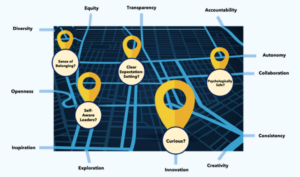
Employee Onboarding Excellence: How to Succeed From Day One
Sponsored by Firstup. We’ve all encountered employee onboarding nightmares. Perhaps your manager forgot your start date. Or maybe the tools and technology assigned to you didn’t

Sponsored by Firstup. We’ve all encountered employee onboarding nightmares. Perhaps your manager forgot your start date. Or maybe the tools and technology assigned to you didn’t

These are exciting times for anyone involved in employee learning. As generative AI becomes mainstream, the learning content authoring possibilities seem endless. However, cool content

Artificial intelligence. Some leaders love it. Some have accepted it. Others still have serious questions about it. But whatever your opinion may be, there is

Let’s go back in time. Way back to 1997. Apple’s high-flying identity as a tech innovator had been seriously tarnished. It certainly wasn’t the global

Sponsored by The Culture Platform What makes maps so special is they tell you exactly where to find places you want to visit. Wouldn’t it

Sponsored by The Culture Platform What tools actually help managers manage their people? That’s the most important question every organization needs to ask itself as the

If pay transparency isn’t yet a hot topic in your organization, it soon will be. Recently, several states have passed pay transparency laws, and others

No question about it. Strong internal communication is critical to a strong business. But it’s not easy — especially when workplace dynamics are constantly fluctuating.

When it comes to implementing a successful engagement strategy, HR teams can’t afford to ignore employee expectations. Yet, research suggests that too many organizations forget

A strong internal communications function is essential for every company, both culturally and operationally. It helps keep employees aware of relevant news and updates, excited

In today’s challenging talent environment, retaining employees is a must. That’s why so many organizations consider onboarding new hires a top priority. When people feel

As employee engagement continues to drift downward, organizations everywhere are looking for more efficient, effective ways to connect and communicate with their workforce. This is

Open enrollment season is upon us again, and the world of work continues to shift at a head-spinning pace. This fluid environment poses benefits-related challenges
The conversation went something like this: Me: “Hi Sean! I’m writing a blog post for TalentCulture.com about the benefits of creating employee-focused communications that are

Listening — it can be a powerful tool for business leaders. But developing the habit of mindful listening requires practice. Here are tips to help.

We all have those days when we need to face the music with our manager. But how can we make the most of a bad work situation?

What makes an effective leader? Dan Newman, author of “The Millennial CEO,” helps us take a closer look…

Social engagement is not a management overlay on a toxic culture. It’s not a Band-Aid, a work-around or a cure-all. But what DOES it take to be an effective social leader in today’s world of work?

Customer and employee engagement are similar in many ways. Here’s how customer experience disconnects can inspire better employee communications…